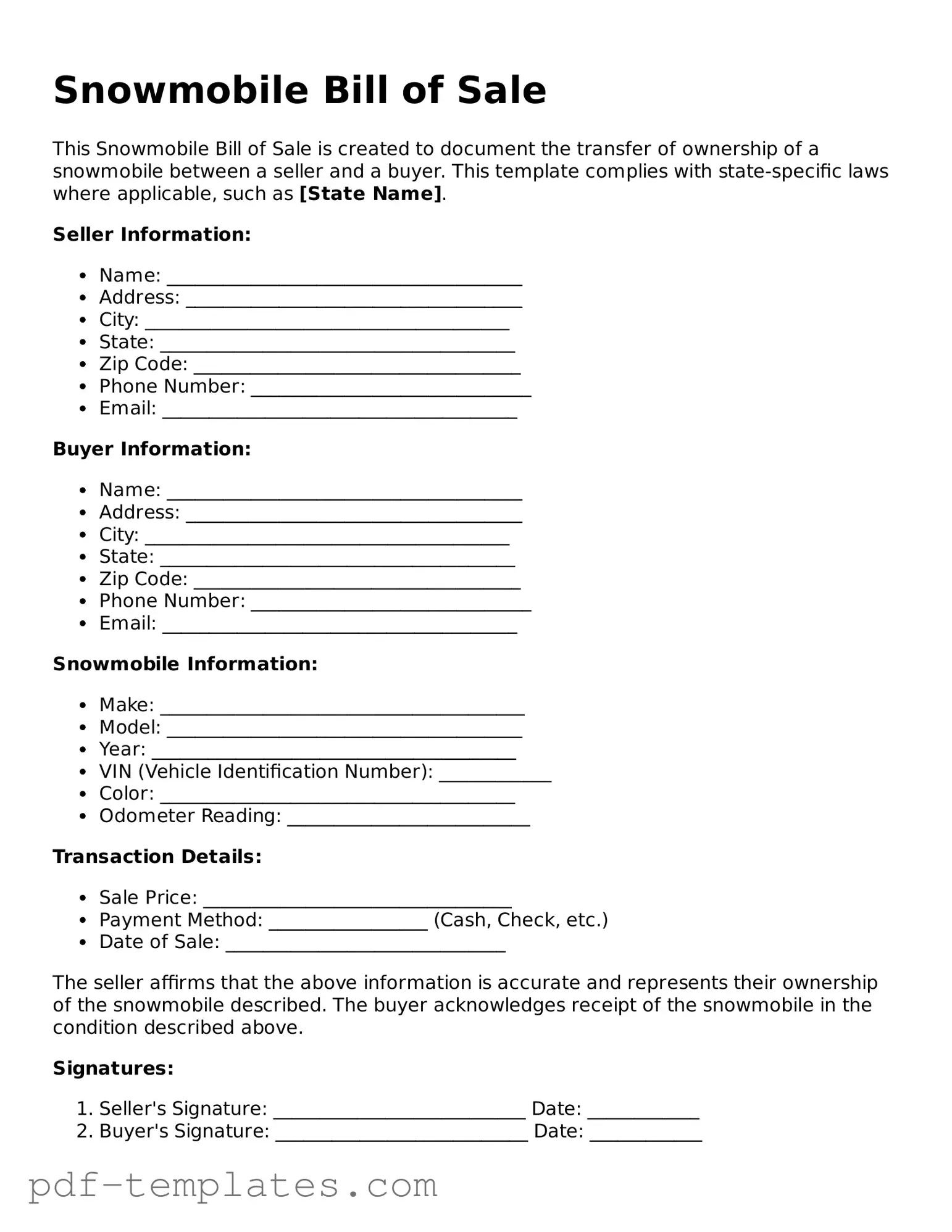The Snowmobile Bill of Sale form is similar to the Vehicle Bill of Sale. Both documents serve as legal proof of the transaction between a buyer and a seller. They typically include essential details such as the purchase price, vehicle identification number (VIN), and the names and addresses of both parties. This ensures that the transfer of ownership is documented properly, protecting both parties in the event of a dispute. Just like the Snowmobile Bill of Sale, the Vehicle Bill of Sale may also require signatures from both the buyer and the seller, confirming their agreement to the terms outlined in the document.
Another document akin to the Snowmobile Bill of Sale is the Motorcycle Bill of Sale. This document is used when buying or selling a motorcycle and contains similar elements. It includes information about the motorcycle, such as make, model, and VIN, along with the purchase price and the parties involved. Both documents are crucial for establishing ownership and can be used to register the vehicle with the appropriate state authorities. They also serve as a record for potential future sales or legal matters.
The Boat Bill of Sale shares similarities with the Snowmobile Bill of Sale, as both pertain to recreational vehicles. This document outlines the terms of sale for a boat, including details such as the hull identification number (HIN), purchase price, and buyer and seller information. Like the Snowmobile Bill of Sale, it acts as a legal record of the transaction and may be required for registration purposes. Both documents help ensure that ownership is clearly transferred, which is vital for the buyer's rights to the property.
In addition to the various bills of sale discussed, those looking to purchase a vehicle in Texas should also be aware of the Texas Vehicle Purchase Agreement, which is a crucial legal document in the vehicle sale process. This agreement outlines essential terms and conditions of the sale, ensuring that both the buyer and seller have a clear understanding of the transaction. To access a template for this important document, you can visit documentonline.org/blank-texas-vehicle-purchase-agreement, which provides a reliable resource for drafting a comprehensive agreement that protects both parties involved.
In addition, the ATV Bill of Sale is another comparable document. This form is used when selling or purchasing an all-terrain vehicle (ATV) and contains similar information to the Snowmobile Bill of Sale. It typically lists the ATV's make, model, VIN, and the transaction details. Both documents serve the purpose of transferring ownership and protecting the interests of both the buyer and the seller, providing a clear record of the transaction.
The Trailer Bill of Sale is also relevant in this context. This document is utilized when buying or selling a trailer, whether it’s for transporting a snowmobile or other equipment. Much like the Snowmobile Bill of Sale, it includes details about the trailer, such as the VIN, purchase price, and the names of both parties. It serves as a legal record of the transaction and can be essential for registration and ownership verification.
The Aircraft Bill of Sale is another document that parallels the Snowmobile Bill of Sale. While it pertains to the sale of an aircraft, its purpose is similar: to document the transfer of ownership. It includes details such as the aircraft's make, model, and serial number, along with the purchase price and buyer and seller information. Both documents ensure that ownership is officially recognized and can be referenced in future transactions or legal situations.
Additionally, the Livestock Bill of Sale is comparable in that it documents the sale of livestock, such as horses or cattle. This document includes information about the animals being sold, the purchase price, and the parties involved. Similar to the Snowmobile Bill of Sale, it serves to protect both the buyer and the seller by providing a written record of the transaction, which can be important for ownership verification and legal protection.
The Personal Property Bill of Sale is another relevant document. This form is used for the sale of various personal items, such as furniture or electronics. It includes details about the items being sold, the purchase price, and the parties involved. Like the Snowmobile Bill of Sale, it provides a legal record of the transaction, helping to protect both parties in case of disputes regarding ownership or condition of the items sold.
Lastly, the General Bill of Sale encompasses a broader range of transactions. It can be used for any type of personal property transfer, including items not specifically covered by other bills of sale. This document outlines the details of the sale, including the items involved, purchase price, and the names of the buyer and seller. Just as with the Snowmobile Bill of Sale, it serves as a formal record of the transaction, ensuring that both parties have a clear understanding of the sale and their respective rights.
